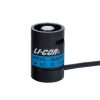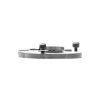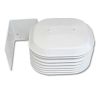HOBO MX2308 Temp/RH/PAR Logger
Features
- Fast, easy logger setup and download via phone or tablet (up to ~100 ft range)
- PAR sensor delivers research-grade light intensity for both sunlight and indoor grow light conditions
- Automatically calculate VPD for a complete view of greenhouse climate conditions
- Free ground shipping
- Expedited repair and warranty service
- Lifetime technical support
- More
Overview
Rugged and Bluetooth-enabled, the MX2308 delivers research-grade monitoring of key growing conditions—photosynthetically active radiation (PAR), temperature and relative humidity—all in a single device. Whether you’re growing plants in a commercial greenhouse, managing indoor vertical farms, fine-tuning conditions in hydroponic systems, or conducting agricultural or ecological research, the MX2308 gives you the data you need to optimize conditions for growth, health, and productivity.
Built for simplicity and flexibility, this all-in-one logger integrates with the LI-COR 190R PAR sensor, the industry standard for light measurement that's trusted by researchers worldwide for its precision in measuring photosynthetically active radiation (PAR). This versatile logger is designed to operate reliably across diverse environments, from high-tech vertical farming racks to outdoor experimental plots to support informed decisions around lighting, ventilation, and irrigation without the complexity or high costs of traditional monitoring systems:
Examples of Monitoring Applications for the MX2308 Temp/RH/PAR Logger:
- Growers, Farmers & Producers: Helps optimize growing conditions, improve yield consistency, and reduce disease risk for commercial greenhouse and indoor farming operators and hydroponic/aquaponic growers by monitoring where it matters most.em 1 text.
- Researchers & Educators: Wireless setup and data retrieval enable flexible deployment across experimental sites, with data quality ideal for agricultural researchers, plant scientists, and university programs without the budgetary or logistical barriers typical of research-grade systems.
- Ag Tech & Innovation Teams: Ease of deployment and integration-ready data formats make an ideal sensor platform for prototyping or scaled trials needed for companies innovating in lighting optimization and climate control solutions.
Setup and data retrieval are seamlessly simple—no cables or additional download devices needed using the free HOBOconnect app on your phone or tablet. Effortlessly configure the logger and download data via Bluetooth (up to a 100 ft range), which allows you to deploy in and download data from hard-to-reach spots.
Expand your remote monitoring by adding an MX Data Plan, which allows you to upload data to LI-COR Cloud remote software for further analysis, sharing, and more.
Temperature: -40 to 70 °C (-40 to 158 °F); Accuracy ±0.2 °C (typical) within 0 to 70 °C; Resolution 0.04 °C
Relative Humidity: Range 0–100% RH; Accuracy ±2.5% (typical) from 10% to 90% RH; Resolution 0.01% RH
PAR Range: 0 to 3,000 μmol/m²/s (full sunlight)
PAR Accuracy: ±5% typical (LI-190R factory calibration)
PAR Spectral Range: 400–700 nm (PAR waveband)
Calculated Metrics: Vapor Pressure Deficit (VPD) in kPa, and Daily Light Integral (DLI) in mol/m²/day (computed from logged data)
Logging Interval: User-selectable from 1 second up to 18 hours
Memory Capacity: ~35,000 sets of measurements
Wireless Range: Up to 30.5 m (100 feet) line-of-sight via BLE
Enclosure Rating: IP67 (NEMA 6)
Battery: 2/3 AA 3.6 Volt Lithium; User-replaceable
Operating Environment: -40 to 70 °C, 0–100% RH
In The News
From Paddles to Phytoplankton: Studying Vermont’s Wildest Lakes
For six months of the year, Rachel Cray, a third-year PhD student at the Vermont Limnology Laboratory at the University of Vermont, lives between a microscope and her laptop, running data. For the other six months, she is hiking and canoeing four of Vermont’s lakes, collecting bi-weekly water samples. Cray studies algal phenology across four lakes in Vermont, US, that have low anthropogenic stress—or in other words, are very remote. Funded by the National Science Foundation Career Award to Dr. Mindy Morales, the lakes Cray researches part of the Vermont Sentinel Lakes Program, which studies 13 lakes in the area and, in turn, feeds into the Regional Monitoring Network, which operates in the Northeast and Midwest US.
Read MoreReimagining Water Filtration: How Monitoring and Science Enhance FloWater Filtration Systems
Over 50% of Americans think their tap water is unsafe , according to the Environmental Working Group (EWG). Other recent surveys have found that number to be as high as 70% of persons surveyed. Whether due to increased public awareness of water quality issues or confusion about how municipal water sources are regulated, there is a clear distrust of tap water in the United States. According to industry expert Rich Razgaitis, CEO and co-founder of the water purification company FloWater, this issue creates a damaging cycle. Razgaitis explained that the health and environmental problems associated with contaminated water aren’t the only issues. As people become increasingly aware that some tap water is unsafe, they resort to bottled water.
Read MoreMonitoring New Hampshire’s Aquatic Ecosystems: Continuous Data Collection in the Lamprey River Watershed
New Hampshire’s aquatic ecosystems provide a range of ecosystem services to the state and region. Resources and services like clean water, carbon storage, climate regulation, nutrient regulation, and opportunities for recreation all depend on New Hampshire’s aquatic ecosystems remaining healthy. Jody Potter, an analytical instrumentation scientist at the University of New Hampshire (UNH), is studying these aquatic ecosystems in hopes of developing an improved understanding of ecosystem services and their interactions with climate change, climate variability, and land use changes. [caption id="attachment_39799" align="alignnone" width="940"] Aquatic sensors in the Merrimack River in Bedford, NH, with I-293 in the background.
Read More

















